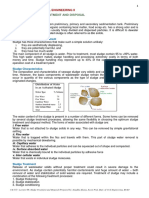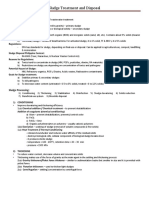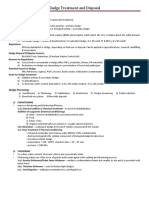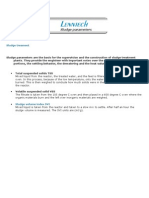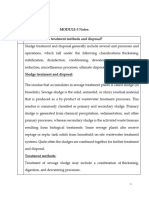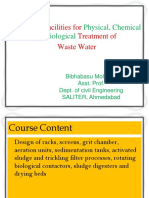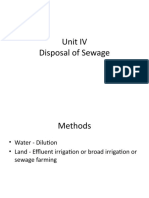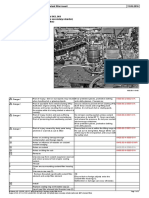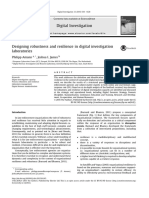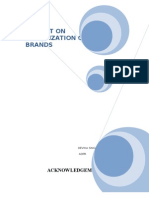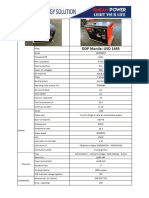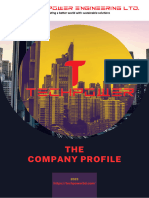SLUDGE HANDLING
AND DISPOSAL
Prepared By Alamin Hossain
General
� Sludge refers to the residual, semi-solid material left from
industrial wastewater, or sewage treatment processes.
Sustainable sludge handling may be defined as a socially
acceptable, cost-effective method
that meets the requirement of efficient recycling of
resources while ensuring that harmful substances are not
transferred to humans or the environment.
Prepared By Alamin Hossain
General
� Sludge handling processes
1. Primary operations
2. Thickening
3. Stabilization
4. Conditioning
5. Dewatering
6. Heat drying
7. Incineration
Prepared By Alamin Hossain
General
� 1.Primary operations
This process includes
Grinding
-particle size reduction
Screening
-removal of fibrous materials
Degritting
-grit removal
Blending
-homogenization
Storage
-flow equalization
Prepared By Alamin Hossain
General
� Advanced Primary Treatment1
Using higher dosage of chemical coagulant/flocculent to
remove not only suspended solids but also the soluble
organic matter
APT will also provide
persistent sulfide
odor absorption
Prepared By Alamin Hossain
General
� APT program requires addition of the Ferric Chloride(3
to 15ppm ferric iron)at a point just upstream of the
primary clarifiers.
In general the higher the dosage of coagulant the more
BOD will removed, but dosage will limited by amount of
alkalinity available and by economy
Prepared By Alamin Hossain
General
� 2. Thickening
To increase solids content percentage of sludge by
removing a portion of liquid fraction
volume reduction of approximately 30 – 80 % can be
reached with sludge thickening2
METHODS :-
gravity thickening
flotation thickening
Centrifugation
Rotatary drum thickening
Prepared By Alamin Hossain
General
� 3. Stabilization
Objectives
Reduce pathogens
Eliminate offensive odors
Reduce potential for putrefaction
Production of usable gas (methane).
Mechanisms
o Biological reduction of volatile content
o Application of heat to disinfect sludge
Prepared By Alamin Hossain
General
� Methods of stabilization
Alkaline stabilization :
lime is added to untreated sludge ,
to raise the PH to 12 or
higher .
Retards microbial reaction .
Materials such as cement kiln dust
,fly ash are used instead of lime .
Prepared By Alamin Hossain
General
� Anaerobic digestion
A biological process that uses bacteria in an oxygen
free environment.
These bacteria converts volatile solids into carbon
dioxide, methane and ammonia .
single stage digester
Prepared By Alamin Hossain
General
� Aerobic digestion
Organic part decomposes in presence of oxygen by
micro organisms .
Mostly used in plants with average flow less than 5 MGD
.
Bacteria converts organic matter into carbon dioxide .
Prepared By Alamin Hossain
General
� Advantages and disadvantages of aerobic
digestion
Advantages Disadvantages
Lower capital cost High power cost
End product odourless and stable Digested solids have poorer dewatering
characteristics
Lower BOD concentrations in Useful by product such as methane is not
supernatant liquor recovered
More basic fertilizer values
recovered
Prepared By Alamin Hossain
General
� 4.Conditioning
In this process sludge solids are
treated with chemicals or other means
to prepare sludge for dewatering.
It improves the drainability of digested
sludge. Sludge becomes more
amenable to dewatering.
It can be achieved by various methods
such as elutriation, chemical
conditioning, heat
treatment, freezing etc.
Prepared By Alamin Hossain
General
� 5.Dewatering
A physical unit operation used to reduce the moisture
content of sludge
Difficulty due to fact that particles are very fine,
colloidal in nature and possess a gel-like structure due
to polymeric flocculation
Compared to thermal (evaporative processes) for water
reduction, mechanical dewatering is often selected due
to its low energy requirement
3
Prepared By Alamin Hossain
General
� Methods of dewatering
1. Centrifugation – for separating liquids
of different densities, thickening
slurries .
Prepared By Alamin Hossain
General
� 2. Belt filter press
Uses principle of gravity drainage and mechanically
applied pressure.
Prepared By Alamin Hossain
General
� 6. Heat drying
It involves the application of heat to
evaporate water and to reduce the
moisture content of biosolids through
conduction, convection or radiation .
Advantage of this method is to reduce
product transportation costs, improve
storage capability, and marketability.
Prepared By Alamin Hossain
General
� Methods of heat drying
1. Direct drying- the wastewater solids come into
contact with hot gases, which cause evaporation of
moisture.
Dryers such as rotary dryer and fluidized bed dryer are
used.
Prepared By Alamin Hossain
General
� Indirect drying- Moisture evaporates when the wastewater solids contact
the metal surface heated by the hot medium. Dryers such as paddle dryers
,hollow flight and disc dryers are used.
paddle dryer
Prepared By Alamin Hossain
General
� Volume reduction
Thickening Dewatering Drying
50
45
.
40
35
mass [t] (volume [m³])
30
25
20
15
10 Water
5 Dry matter
0
1 10 20 30 40 50 60 70 80 90 100
dry matter [%]
Prepared By Alamin Hossain
General
� 7.Incineration
Involves total conversion of organic solids to oxidized end products
Sludge stabilization is not necessary before incineration .
Water, carbon-dioxide and ash are primarily end products .
The sludge generally has calorific values
ranging from11 to 17 MJ/kg
(reference :Werle and Wilk,2010)4
Prepared By Alamin Hossain
General
� Methods of incineration
1. multiple hearth incinerator
Dewatered sludge
to dry ash.
used in large plants.
Prepared By Alamin Hossain
General
� 2. FLUIDIZED BED
INCINERATION
wastes are quickly
and uniformly
incinerated with
utilizing
thermal capacity
of hot fluidizing
sand
Prepared By Alamin Hossain
General
� Advantages of incineration
Energy recovery potential 5
Pathogens would be reduced by a
pasteurization process
Waste volume reduction
Destruction of combustible toxins
Prepared By Alamin Hossain
General
� Disadvantages
Emission of mercury & NOx leading to air
pollution
High capital and operational costs
Ash must be landfilled and may be
hazardous
Prepared By Alamin Hossain
General
� Sludge disposal
Sewage sludge contains both compounds of agricultural
value and pollutants.
Agriculture value- organic matter, nitrogen, phosphorus
and potassium.
Pollutants- heavy metals, organic pollutants and
pathogens
Prepared By Alamin Hossain
General
� Methods of Sludge disposal
1. Land fill
2. Agricultural use
3. Other methods
Prepared By Alamin Hossain
General
� Landfill
A site for the disposal of waste materials by burial and is the oldest form
of waste disposal.
Some landfills are also used for waste management purposes, such as the
temporary storage, consolidation and transfer, or processing of waste
material (sorting, treatment, or recycling).
Problem with this method is that many landfills are filling up, and towns
are having trouble finding places to put new ones.
Prepared By Alamin Hossain
General
� Prepared By Alamin Hossain
General
� Agricultural use
The purpose of using sludge in agriculture is
partly to utilize nutrients such as phosphorus
and nitrogen and partly to utilize organic
substances for soil improvement.
All types of sludge can be spread on farmland if they
fulfill the quality requirements (heavy metals,
pathogens, pre- treatment)
Prepared By Alamin Hossain
General
� Advantages
Utilization of nutrients contained in the sludge, i.e.
phosphorus and nitrogen.
Utilization of organic substances contained
in the sludge for improvement of the humus layer of the
soil (i.e. soil improvement).
The cheapest disposal route
Prepared By Alamin Hossain
General
� Disadvantages
Major investments in storage facilities as sludge can
only be spread on farmland a few times a year.
Dependency on the individual farmers and considerable
administration of agreements
Lack of knowledge as to the content of organic micro-
pollutants and pathogenic organisms in sludge and their
impact on the food chains
Prepared By Alamin Hossain
General
� Other methods
Ocean Disposal – Dumping or controlled release of sewage sludge from a
barge or other vessel into marine water.
Distribution and Marketing – The give-away, transfer, or sale of sewage
sludge or sewage sludge product in either bagged or bulk form.
Surface Disposal – A controlled area of land where only sewage sludge is
placed for a period of one year or longer. Sludge placed in this area is not
provided with a daily or final cover.
Prepared By Alamin Hossain
General
� References
1.http://www.californiawatertechnologies.com/pdf/APTBulletin.pdf
2. http://www.lenntech.com/library/sludge/thickening/sludgethicke
ning.htm#ixzz3BV2qbCFu
3. Vaxelaire J, Bongiovanni JM, Puiggali JR (1999) Mechanical
dewatering and thermal drying
of residual sludge. Environ Technol 20:29–36
4. Werle and Wilk,2010
5. U. S. EPA (1985), seminar publications composting of municipal
wastewater, EPA/625/4-85/014
6. Wastewater Treatment By Metcalf & Eddy, TMH
Prepared By Alamin Hossain
General
� THANK YOU
Prepared By Alamin Hossain
General
















